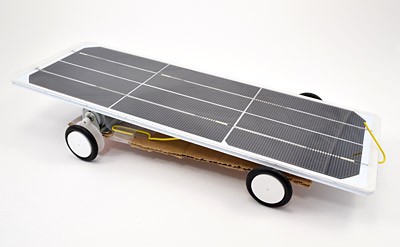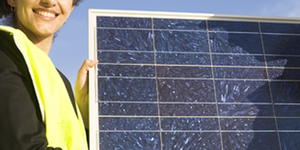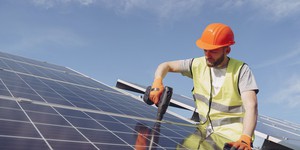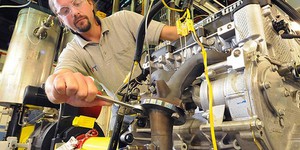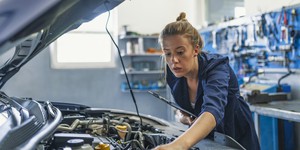Abstract
Do you want to build a solar-powered car? How about enter it in a competition and race it against other people's designs? If so, this is the project for you! These instructions will show you how to get started building a solar-powered car that you can enter in a science or engineering fair. No experience needed. If you want, you can even compete in the Junior Solar Sprint, a regional competition for solar-powered cars. Get more information about your regional competition.
Are you a teacher? Try the classroom lesson plan version of this project. It contains special information just for educators.
Summary
Objective
Design and build a solar-powered car.
Introduction
Solar power is power we get from the sun. Unlike fossil fuels, which can cause significant pollution and emit greenhouse gases when burned, solar power is clean and renewable. However, solar power is not without its drawbacks—it is not available at night or on a cloudy day.
Solar panels convert sunlight into electrical energy, which can be used to power machines like motors. They must be connected to the motor by wires to form a circuit. A motor can be used to drive the wheels of a solar-powered car (Figure 1). In order to build a solar car, you need to be familiar with the basic parts that make up a typical car:
- The chassis is the car's frame, or body.
- The axles are straight, rigid rods that support the wheels.
- The bearings connect the axles to the chassis and allow them to spin.
- The motor converts electrical energy from the solar panel into spinning motion. It has a metal shaft that spins.
- The transmission transmits rotating motion from the motor's shaft to an axle.
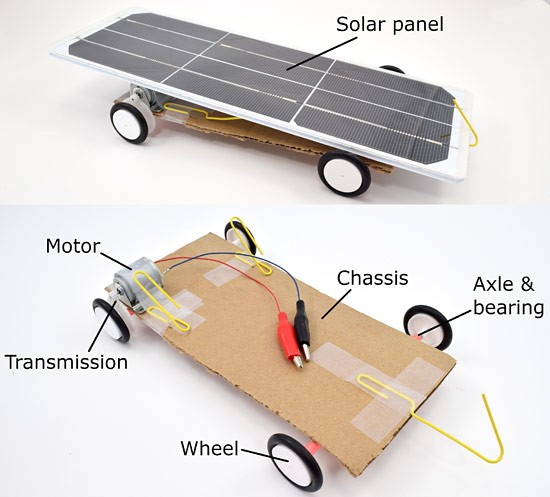 Image Credit: Ben Finio, Science Buddies / Science Buddies
Image Credit: Ben Finio, Science Buddies / Science BuddiesPhotos of a solar-powered car made from parts ordered online. The chassis of the solar power car is made from a rectangular piece of cardboard cut to a slightly smaller length than the solar panel. Attached to the bottom of the cardboard chassis are two straws that will act as axles for four plastic wheels. A motor with two alligator clip leads is taped to the top of the chassis next to a rear wheel that has a gear which will interlock with a gear on the motor. Three paperclips are bent and taped to the top of the chassis to support the solar panel (two at the rear and one at the front).
Figure 1. A solar-powered car (top) and the car with the solar panel removed (bottom) so you can see the other components. This car was built using a kit that supplies the solar panel, motor, axles, gears, and wheels (see Materials section). The chassis is a piece of corrugated cardboard, and straws act as the bearings (note that the straws are under the cardboard, so they are difficult to see in this picture). Paper clips hold the solar panel in place on top of the chassis.
There are several different types of transmissions that you can use for a solar car, shown in Figure 2.
- In a friction drive, a disk on the motor shaft rubs directly against another disk on the axle.
- In a belt drive, a disk on the motor shaft is connected to a disk on the axle by a belt (e.g. a rubber band).
- In a gear drive, a gear on the motor shaft meshes with a gear on the axle.
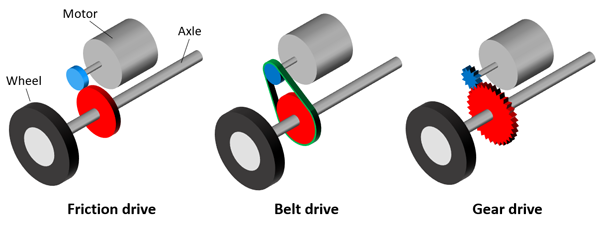 Image Credit: Ben Finio, Science Buddies / Science Buddies
Image Credit: Ben Finio, Science Buddies / Science BuddiesDiagrams of three different transmission types (friction drive, belt drive, and gear drive). In friction drive, energy is transferred from the motor to the axle using two disks that are in contact with eathother. In belt drive, energy is transferred by a belt wrapped around disks on the motor and axle. In geared drive, two gears are used to transfer energy between the motor and axle.
Figure 2. Different types of transmissions.
There are different engineering and physics concepts you will need to take into account when designing and building a solar car. Some decisions may involve trade-offs between different factors. There is no single "correct" way to build a car. Some of the factors you should consider are listed below. Additional resources listed in the Bibliography can help you learn more about these topics.
- Mass and stiffness: what material(s) will you use to make your chassis? Different materials have different densities (mass per unit volume) and stiffnesses (resistance to bending/flexing). In general, you want a chassis to be stiff and not too flexible. Your motor will have a hard time moving a very heavy chassis. However, if a chassis is too light, it could be blown around easily by the wind, or its tires might slip because there is not enough friction with the ground (see next point).
- Friction is the force that resists two surfaces sliding against each other. Sometimes friction is bad—you want your bearings and axles to have as little friction between them as possible, so the axles can spin freely. However, sometimes friction is good—you want your tires to have a lot of friction with the ground so they do not slip.
- The gear ratio is the ratio between the diameter of the drive gear on the motor shaft and the driven gear on the axle. This number tells you how many times the driven gear will rotate for each rotation of the drive gear. For example, if the driven gear is five times bigger in diameter than the drive gear, then whenever the drive gear completes one full rotation, the driven gear will complete 1/5 of a rotation. Note that this concept also applies to friction drives and belt drives, and more generally can be called the transmission ratio.
- Adjusting the transmission ratio allows you to adjust the speed of your motor, measured in rotations per minute or RPM, and the torque of the motor. There is a trade-off between these two quantities (if you increase the RPM, you decrease the torque, and vice versa). You may need to experiment to find out what gear ratio makes your car go the fastest.
- The angle of the solar panel relative to the sun's rays affects how much electrical power it produces. It will produce the most power when the panel is perpendicular to the sun's rays.
If you experiment one by one with a few of these variables, and keep track of your results, you can design a great solar-powered car. Optionally, you can enter your car in the Junior Solar Sprint contest if there is one in your area. For more information, check your regional branch.
Terms and Concepts
- Solar power
- Fossil fuels
- Renewable
- Solar panel
- Circuit
- Chassis
- Axle
- Wheel
- Bearing
- Motor
- Shaft
- Transmission
- Friction drive
- Belt drive
- Gear drive
- Mass
- Stiffness
- Friction
- Gear ratio
- Transmission ratio
- Drive gear
- Driven gear
- Rotations per minute (RPM)
- Torque
- Angle
Questions
- What materials could you use to build the different parts of a solar car?
- What are the different types of transmissions?
Bibliography
- Holly, K. and Madhani, A. (Aug. 23, 2001). Junior Solar Sprint - An Introduction to Building a Model Solar Car. National Renewable Energy Laboratory. Retrieved September 5, 2018.
- Henderson, T. (n.d.). Friction Force. The Physics Classroom. Retrieved September 7, 2018.
- Science Buddies Staff (n.d.). The Engineering Design Process. Science Buddies. Retrieved September 9, 2018.
Materials and Equipment
- At a minimum, you will need to purchase an official solar panel and motor for your car. Decide if you want to build the other components from scratch, or purchase a kit that includes additional parts. The official vendors for the Junior Solar Sprint competition, Solar Made and Pitsco, have a variety of options (ranging from just the motor/solar panel to a complete car kit, including a balsa wood chassis, axles, gears, and wheels):
- If you want to build your own parts from scratch, here are some suggestions for materials:
- Chassis: corrugated cardboard, balsa wood, Styrofoam®, milk/juice cartons, cardboard tubes
- Axles: metal coat hanger (cut a straight section), wooden skewer or dowel, any other thin metal rod
- Bearings: drinking straws, eye hooks, holes drilled in chassis material
- Wheels: bottle caps, circles cut from a rigid material (plastic, wood)
- Tires: rubber bands, hot glue along the edge of the wheel
- Transmission: gears salvaged from toys or an electronic device like a VCR or DVD player, small disks (like Dremel® rotary tool attachments), rubber bands
- Depending on the materials you choose, you may need other miscellaneous tools or supplies (power drill, hot glue gun, scissors, pliers, etc.). Important: make sure you use tape/glue that won't melt or soften in the sun on a hot day!
- You will also need a flat, paved, sunny area to test your car, and a volunteer to help catch your car (they can be fast!).
- Download a free project packet to draw your sketches, organize your project, and make sure you have all the parts you need to enter the Junior Solar Sprint competition.
- Download examples of technical drawings for information on how to make professional drawings of your final solar car design.
Disclaimer: Science Buddies participates in affiliate programs with Home Science Tools, Amazon.com, Carolina Biological, and Jameco Electronics. Proceeds from the affiliate programs help support Science Buddies, a 501(c)(3) public charity, and keep our resources free for everyone. Our top priority is student learning. If you have any comments (positive or negative) related to purchases you've made for science projects from recommendations on our site, please let us know. Write to us at scibuddy@sciencebuddies.org.
Experimental Procedure
Teachers, try our classroom lesson plan version of this project instead. It has extra resources for schools. Students, this version of the project was made specifically for you.
Planning Your Solar Car
- Sketch what you want your solar car to look like. What materials will you use? How will all the parts fit together? You can use the free project packet to do your sketches and keep track of your project. If you are thinking of racing your car in a local Junior Solar Sprint competition, using the project packet will help make sure you have all the parts you need to enter the competition!
- If you are considering entering the Junior Solar Sprint competition, make sure to follow the car sketching and building rules in Table 1. More detailed, official rules can also be downloaded.
| Category | Rule |
|---|---|
| Car Materials | Cost cannot exceed $50 (not including recycled materials). Keep all receipts. |
| Do not modify (cut, drill, disassemble, etc) solar panel or motor. | |
| Car Design | Solar panel cannot be used as chassis/body of car. Axles and wheels cannot be directly attached to solar panel. |
| Dimensions (with solar panel attached) cannot exceed 60 x 30 x 30cm. | |
| Motor leads must be accessible order to connect 2xAA battery pack if there is not enough sunlight on competition day. | |
| Car must be able to attach to a guide wire that is 1.5cm off the ground, without untying one end of the guide wire. | |
| Process | Every time you work on your solar car project, make an entry in your log. |
| Use the pages in this packet to help you design your car. |
Building a Starter Car
Now it is time to build your car. The video and step-by-step directions in this section show you how to build a very basic solar car. It is pretty rickety though and will fall apart easily! It is meant as an example. Feel free to build it, it won't take long, and then use the information you learned from building and testing it to build an awesome version of the car you sketched. Remember to fill in the pages of your project packet as you work!
- Depending on where you purchased your motor, you will need to solder wires to it and/or crimp alligator clips onto the wires (Figure 3).
- If necessary, solder two wires to the tabs on the back of the motor (get an adult to help you with soldering).
- Remove the plastic covers from the alligator clips, and slide them onto the wires.
- Use needle-nose pliers to tightly crimp the alligator clips onto the bare metal ends of the wires.
- Slide the plastic covers back over the alligator clips.
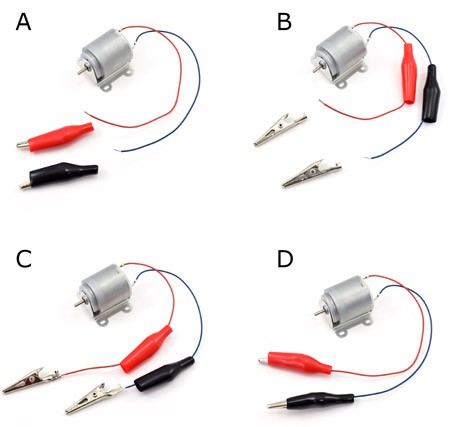 Image Credit: Ben Finio, Science Buddies / Science Buddies
Image Credit: Ben Finio, Science Buddies / Science Buddies
Figure 3. How to attach alligator clips to the motor wires.
- Connect your wheels, axles, and bearings. Figure 4 shows axles (metal rods) inside the bearings (straws). Each axle has two wheels (plastic discs with rubber tires) that are press-fit onto the ends of the axle. One of the axles also has a plastic gear pressed on, which will form part of the transmission. You need to plan ahead to think about how this gear (the driven gear) will align with the gear on the motor shaft (the drive gear).
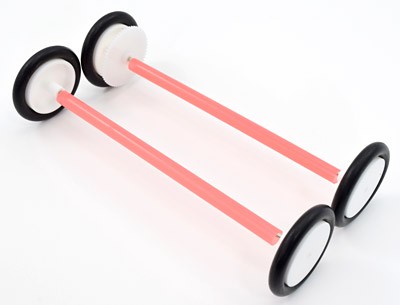 Image Credit: Ben Finio, Science Buddies / Science Buddies
Image Credit: Ben Finio, Science Buddies / Science Buddies
Figure 4. Axles with wheels, bearings, and a gear on one of the axles.
- Construct your chassis.
- Connect your axles/bearings to your chassis. Figure 5 shows the axles/bearings connected to the underside of the chassis (a piece of corrugated cardboard) with tape.
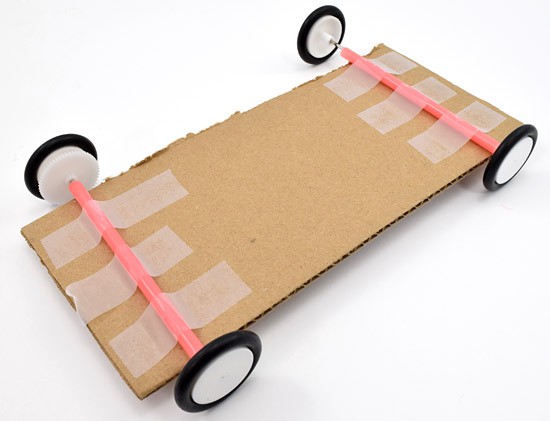 Image Credit: Ben Finio, Science Buddies / Science Buddies
Image Credit: Ben Finio, Science Buddies / Science Buddies
Figure 5. Axles/bearings connected to chassis.
- Connect the motor to the chassis and align the transmission. This can be one of the most difficult steps. If your transmission uses gears like the one in Figure 6, you need the teeth of the gears to mesh firmly. If they are too loose or not touching at all, then the motor will just spin without making the axle turn. However, if they are too tight, there might be too much friction and they could jam. You will need to see how it works when you connect the solar panel.
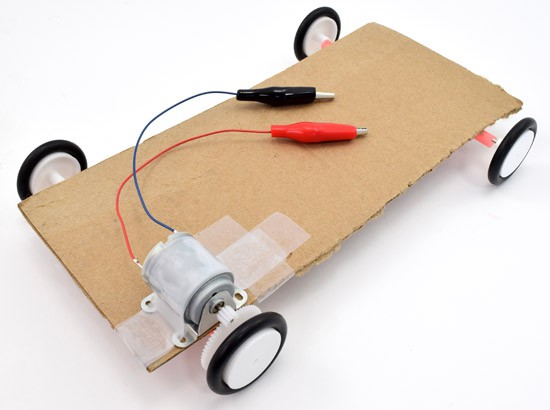 Image Credit: Ben Finio, Science Buddies / Science Buddies
Image Credit: Ben Finio, Science Buddies / Science Buddies
Figure 6. Motor connected to chassis.
- Attach supports for your solar panel to the chassis (Figure 7).
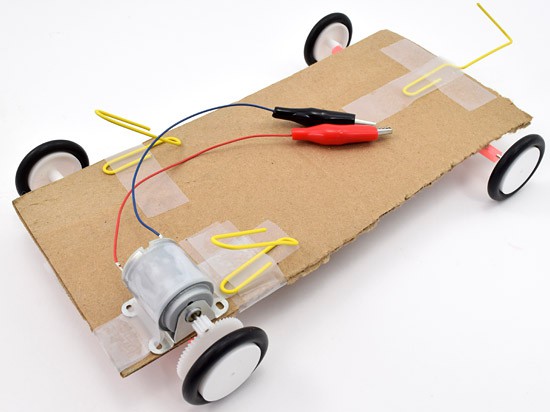 Image Credit: Ben Finio, Science Buddies / Science Buddies
Image Credit: Ben Finio, Science Buddies / Science Buddies
Figure 7. Paper clips as solar panel supports.
- Attach the alligator clips to the two tabs on the back of the solar panel, and secure the solar panel to the chassis (Figure 8). Note: the solar panel is fragile. Make sure you handle it carefully.
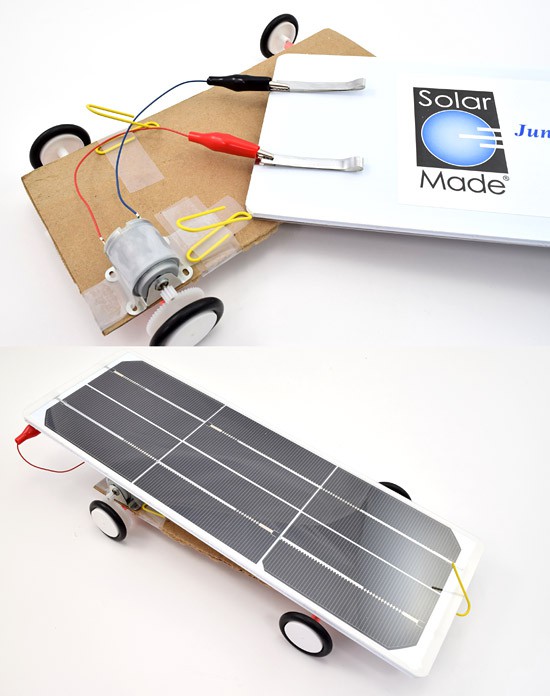 Image Credit: Ben Finio, Science Buddies / Science Buddies
Image Credit: Ben Finio, Science Buddies / Science Buddies
Figure 8. Solar panel attached to the car.
- Now it is time to test your car! Take your car outside in direct sunlight, but do not put it down yet. Hold it in your hands and aim the solar panel towards the sun. If the motor and axle both spin, congratulations! Move on to the next step. If not, try these troubleshooting steps:
- If your motor does not spin at all:
- Make sure you are outside, in direct sunlight, on a sunny day, with the solar panel facing towards the sun. Your solar panel might not generate enough power to spin the motor if you are in the shade or it is cloudy.
- If your motor still does not spin, double-check your circuit. Make sure the alligator clips are firmly connected to the solar panel's metal tabs. If you soldered or crimped your own wire connections, make sure none of them are loose or broken. Repair them if necessary.
- If your circuit is OK, make sure your axle or transmission are not jammed. Does the axle spin if you twist one of the wheels by hand?
- If your motor spins, but the axles does not, make sure the gears are touching each other. You might need to realign your motor or the axle to make sure the teeth of the gears mesh together firmly.
- If your motor does not spin at all:
- Once your motor and axle both spin when you hold the car in the sun, it is time to put your car on the ground and watch it go! But be careful—a working car can move pretty fast. It is a good idea to test your car in a flat, open area free of obstacles that it could crash into. Aim your car towards a volunteer who can catch it, or something soft like a pillow. The solar panel is fragile, so try to avoid letting your car crash. Watch your car carefully when you put it down. How fast does it go? Does it go straight?
Making Your Car Better and Faster
Think about how you could make your car faster. Here are a few suggestions:
- Try to reduce friction in the axles. Could you use other materials for the bearings?
- Make sure the axles are parallel to each other so they roll smoothly without getting stuck.
- Can you make your car lighter by removing material?
- Can you change the angle of the solar panel so it faces the sun directly? Can you make the angle adjustable so you can tilt the panel towards the sun when racing at different times of day or in different directions?
- Make sure your transmission is not slipping. Do you hear a grinding/scratching/rattling noise? Even if your axle is spinning, the gears might occasionally be slipping against each other. Align your transmission so the gears are firmly pressed against each other.
- Try changing the gear ratio. What happens if you use different size gears? You will probably need to realign your motor and/or axle if you try this.
Competing in the Junior Solar Sprint
You will need to make technical drawings of your final solar car design as part of your entry into the Junior Solar Sprint. Directions on how to do this are included in your free project packet. You can also download these examples of technical drawings for more help.
Now you are ready to race! Enter the regional branch of the Junior Solar Sprint nearest you and have fun testing your car against the competition.
Ask an Expert
Global Connections
The United Nations Sustainable Development Goals (UNSDGs) are a blueprint to achieve a better and more sustainable future for all.
Variations
- Do you live in a cloudy climate, or are you unable to do this project outdoors for some reason? Do not worry! You can still build and test a battery-powered car and apply many of the same engineering principles. Instead of a solar panel, purchase a 2xAA battery pack and connect it to your motor.
- Instead of a solar-powered car, can you make a different solar-powered machine? What about a solar-powered fan or artwork with moving parts?
- If your school does not allow engineering projects for their science fair, consider doing a science project with your car. Perform an experiment to determine how changing one variable, like the gear ratio or angle of the solar panel relative to the sun, affects the speed of the car.
Careers
If you like this project, you might enjoy exploring these related careers:



